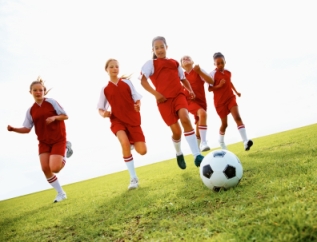Pre- or early adolescence appears to be the best time to start a neuromuscular training program (NMT) in order to reduce the number of injuries female athletes suffer to their anterior cruciate ligaments (ACL), says a new study.1

Performing a "meta-analysis" of data from 14 studies published between 1999 and 2012, researchers at Cinncinati Children's Hospital found a 72% risk reduction in female athletes under 18 years old versus a risk reduction of only 16% for those over age 18. The data indicated that pre- or early adolescents (mid-teens) showed the greatest risk reduction (72%) compared with late adolescents (late teens; 52% risk reduction).
Unexpectedly, the study found that the odds a female athlete would suffer an ACL injury after NMT in early adulthood or their late teens were 3.6 and 1.7 times higher, respectively, than if they began NMT in their mid-teens.
Window of opportunity
The data "could indicate that the potential window of opportunity for optimized ACL injury risk reduction may be before the onset of neuromuscular deficits and peak knee injury incidence that occurs after the onset of maturation in female athletes and/or during the mid-teen years," said lead author, Gregory D. Myer, PhD, FACSM, CSCS, of the Division of Sports Medicine at Cincinnati Children's Hospital, and the Departments of Pediatrics and Orthopaedic Surgery, at the College of Medicine at the University of Cincinnati, and the Athletic Training Division, School of Allied Medical Professions at The Ohio State University in Columbus.
The results "support the contention" - suggested in previous studies - "that younger athletes may be more receptive to NMT, which will lower their risk of injury," Myer writes, "compared with interventions implemented in late adolescents and early adult-aged female athletes.The higher risk of injury in postpubertal athletes has been attributed to several changes that occur thoughout the pubertal period, such as structural/anatomic changes, hormonal variations, and decreased strength."
The study noted that another possible explanation for the great NMT effectiveness in the mid-teen age group may be variability in the "quality" of athletes participating in the cutting, pivoting, and jumping sports such as soccer, volleyball and basketball in the younger ages, so that targeting NMT to athletes who are at higher risk results in greater reduction of that risk.
Key training components
A prior systematic review of the peer-reviewed literature reports that the plyometric training combined with biomechanical analysis and technique-driven feedback were common components in the NMT programs that effectively reduced ACL injury rates, and that balance training alone without feedback-driven instruction was the least effective approach.
The new study links compliance with NMT and lower ACL injury rates. It found that isolated in-season-only training, while it may be effective to improve the needed compliance with exercise training protocols, may not benefit provide an injury-prevention benefit to young athletes in the first half of a competitive season. Thus, Myer writes, "the current data indicates that the most effective and efficient youth injury prevention programs appear to require a combination of components including plyometrics, dynamic stabilization, strength, and feedback-driven technique training, and the effects of these components are potentially additive when employed during both the preseason and season."
Proper instruction and feedback key
A "common thread" throughout the effect NMT protocols, the study found, were proper supervision and feedback on exercises. The two studies that provided limited or no feedback-driven instruction showed no injury-reduction effects of NMT. Therefore, the study said that "age-appropriate education and qualified instruction enhance successful integration of critical components ... related to the mastery of fundamental movements."
The authors recommended that NMT start with fewer repetitions or volume to allow an athlete to develop proper technique, increasing volume only after the athlete can properly perform the exercise at the prescribed volume and intensity. "The professionals who supervise young athletes shold be skilled in recognizing proper technique," Myer writes, "and be able to provide constructive feedback during the learning process, especially during exercises during which improper technique increases injury risk." He concludes that the "benefits of proper exercise instruction and feedback cannot be overlooked in effective NMT programming for youth."
Long-term effects of ACL injury
The long-term effects of an ACL injury are enormous:
- osteoarthritis (OA) rates in the injured knee are between 41% and 51%, between 7 and 10 times the rates in the uninjured knees of soccer players;
- meniscus injury and subsequent surgery have long-term effects on knee joint health, with follow-up reports after meniscus surgery reporting that approximately 50% suffer with knee OA and joint pain and dysfunction.
- Regardless of the treatment (nonoperative management versus reconstructive surgery), OA occurs at 10 times the normal rate in ACL-injured individuals, and 20 years after ACL injury, there is a nearly 100% chance of OA; and
- Another study reported that OA after ACL injury hinders a patient's knee-related quality of life.
"These data provide strong evidence of the need to prevent knee injury, especially in our youth," the study says, although further research in children and adolescents is warranted to investigate the potential to prevent injury with interventions targeted at younger athletes."
1. Myer GD, Sugimoto D, Thomas S, Hewett T. The Influence of Age on the Effectiveness of Neuromuscular Training to Reduce Anterior Cruciate Ligament Injury in Female Athletes. Am. J. Sports Med. 2012; 20(10). DOI:10.1177/0363546512460637 (published online ahead of print October 8, 2012)(accessed October 15, 2012).
Posted October 15, 2012








